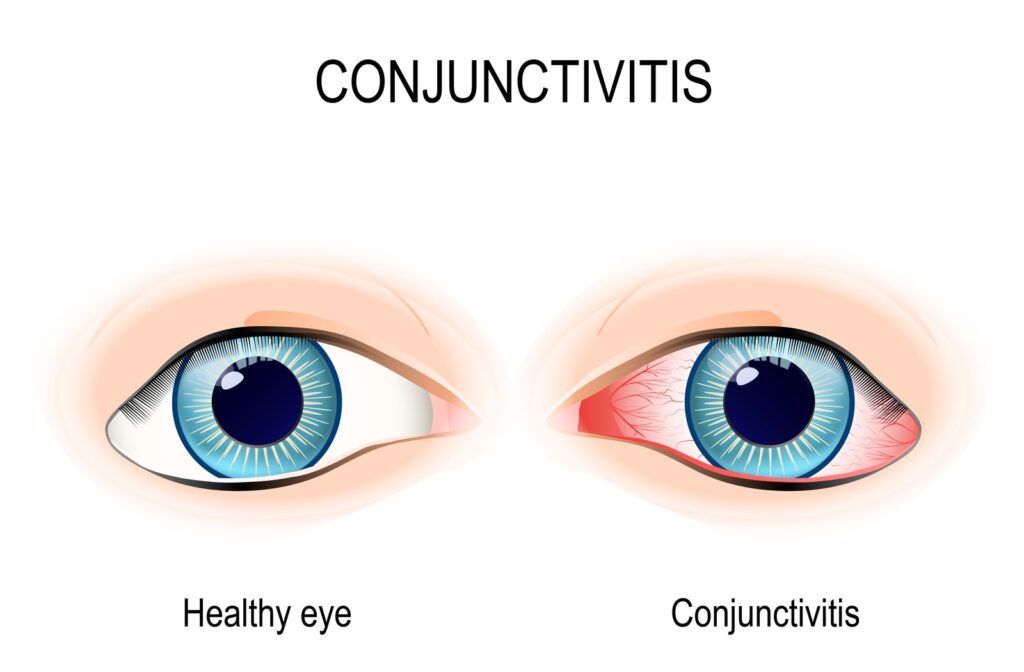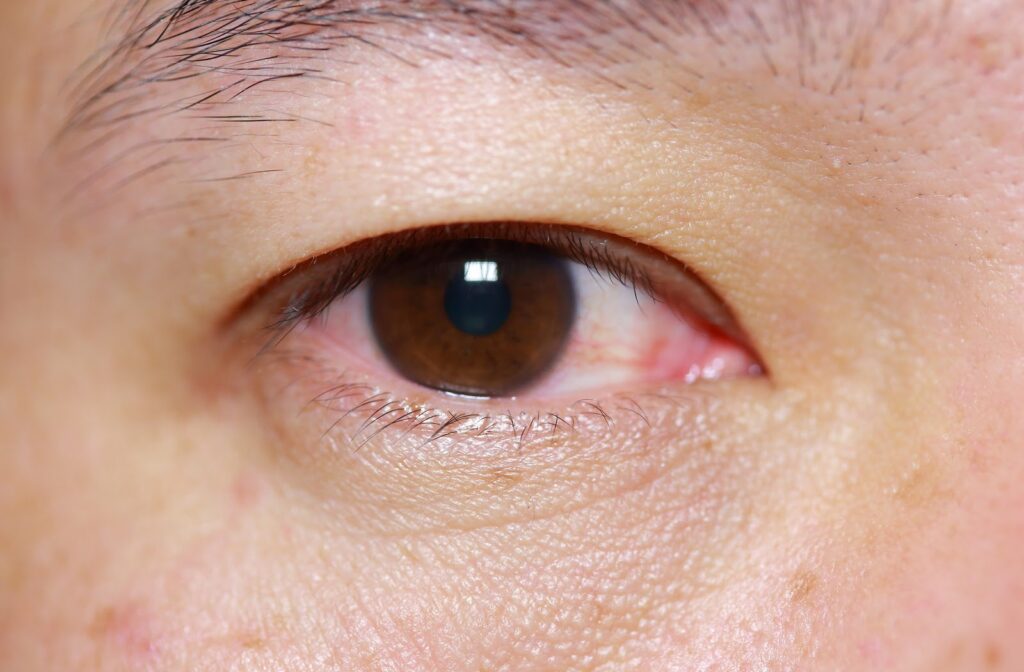Pink eye is one of the most common eye infections in the world. While it can be irritating, a pink eye usually does not harm your ability to see and will clear up on its own within a few weeks. If you are experiencing symptoms of pink eye but are unsure what kind of infection you are dealing with, receiving a diagnostic exam for eye diseases can clear up any uncertainty. Contact Pack & Bianes Vision Care for more information on pink eye and potential treatment options.
What is Pink Eye?
Pink eye, or conjunctivitis, describes the inflammation or infection of the transparent membrane (conjunctiva) that lines your eyelid and covers the white part of your eyeball. When small blood vessels in the conjunctiva become inflamed, they’re more visible. The inflammation of these blood vessels is what causes your eyes to appear red or pink. Pink eye is commonly caused by a bacterial or viral infection, or an allergic reaction.
While pink eye can be annoying and uncomfortable, it rarely affects your vision. Due to pink eye potentially being contagious in some cases, early diagnosis and treatment can help limit its spread.
Symptoms
The most common symptoms of pink eye are:
- Redness in one or both eyes
- Itchiness in one or both eyes
- A gritty feeling in one or both eyes
- A discharge in one or both eyes that forms a crust during the night
- Tearing
Complications
In both children and adults, pink eye can cause inflammation in the cornea that can affect vision. You should seek evaluation and treatment by your doctor for eye pain, foreign body sensation, blurred vision, or light sensitivity to reduce the risk of complications.

Causes of Pink Eye
Viral and Bacterial Conjunctivitis
Pink eye is typically caused by adenovirus, but can also be caused by herpes simplex virus, varicella-zoster virus, and various other viruses, including the virus that causes coronavirus disease 2019 (COVID-19).
Viral and bacterial conjunctivitis can occur along with colds or symptoms of a respiratory infection, such as a sore throat. By wearing contact lenses that aren’t cleaned properly or aren’t your own you increase the risk of developing bacterial conjunctivitis.
Both of these types of conjunctivitis are very contagious. They are spread through direct or indirect contact with the liquid that drains from the eye of someone who’s infected. One or both eyes can be affected by conjunctivitis.
Allergic Conjunctivitis
Allergic conjunctivitis affects both eyes and is a response to an allergy-causing substance such as pollen. In response to allergens, your body produces an antibody called immunoglobulin E (IgE). This antibody triggers cells called mast cells in the mucous lining of your eyes and airways, which then release inflammatory substances, including histamines. Your body’s release of histamine can produce allergy symptoms, including red or pink eyes.
Having allergic conjunctivitis can make you experience intense itching, tearing and inflammation of the eyes, as well as sneezing and watery nasal discharge. Allergic conjunctivitis can typically be controlled with allergy eye drops.
Conjunctivitis Resulting from Irritation
Irritation from a chemical splash or foreign object in your eye is also associated with conjunctivitis. Sometimes cleaning or flushing the eye to wash away the chemical or foreign object can cause redness and irritation. Signs and symptoms of this kind of conjunctivitis will usually clear up on their own within a day.
If flushing or cleaning doesn’t resolve the symptoms, or if the chemical is a caustic one, you need to be seen by a doctor or eye specialist immediately. A chemical splash into the eye can cause permanent eye damage. If you have persistent symptoms, it could also indicate that you still have a foreign body in your eye or a scratch over the cornea.
Risk factors
Risk factors for pink eye include:
- Exposure to something for which you have an allergy (allergic conjunctivitis)
- Exposure to someone infected with the viral or bacterial form of conjunctivitis
- Using contact lenses, especially extended-wear lenses
Diagnosis
In most cases, your doctor can diagnose pink eye by simply asking questions about your symptoms and recent health history.
Rarely, your doctor may need to take a sample of the liquid that drains from your eye for laboratory analysis. Laboratory analysis may be needed if your symptoms are severe, or if your doctor suspects a high-risk cause — such as a foreign body in your eye, a serious bacterial infection, or a sexually transmitted infection.
Can Pink Eye Go Away on Its Own?
In most cases, pink eye will go away on its own and you won’t need antibiotic eye drops. Since conjunctivitis is usually viral, antibiotics won’t help, and may even cause harm by reducing their effectiveness in the future or causing a medication reaction. The virus just needs time to run its course, which usually takes up to two or three weeks.
If the irritation or redness of your eyes is caused by allergies, allergy medication or eye drops can help with treatment and speed up the recovery process. You can also reduce the severity of allergic conjunctivitis symptoms by avoiding whatever causes your allergies when possible.
Viral conjunctivitis will often only begin in one eye and your other eye will become infected within a few days. Your signs and symptoms should gradually clear on their own.
Pink eye treatment is usually geared towards relieving symptoms. Your doctor may recommend using artificial tears, cleaning your eyelids with a wet cloth, and applying cold or warm compresses several times daily.
Antiviral medications may be considered an option if your doctor determines that your viral conjunctivitis is caused by the herpes simplex virus.
You will be advised to stop wearing contact lenses until treatment is complete.
Preventing Pink Eye
Practicing good hygiene is the best way to control the spread of pink eye:
- Don’t touch your eyes with your hands.
- Wash your hands often.
- Use a clean towel and washcloth daily.
- Don’t share towels or washcloths.
- Change your pillowcases often.
- Throw away your eye cosmetics, such as mascara.
- Don’t share eye cosmetics or personal eye-care items.
Keep in mind that pink eye is no more contagious than the common cold. It’s okay to return to your normal routine as long as you are staying consistent in practicing good hygiene.



